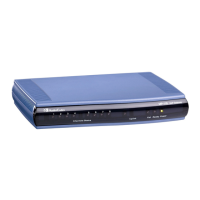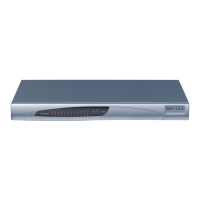INVITE message.
[1] Redirect = Use the same call identifiers.
Web/EMS: Enable P-
Charging Vector
[EnablePChargingVector]
Enables the inclusion of the P-Charging-Vector header to all outgoing
INVITE messages.
[0] Disable (default)
[1] Enable
Web/EMS: Retry-After
Time
[RetryAfterTime]
Defines the time (in seconds) used in the Retry-After header when a
503 (Service Unavailable) response is generated by the device.
The time range is 0 to 3,600. The default value is 0.
Web/EMS: Fake Retry
After [sec]
[FakeRetryAfter]
Determines whether the device, upon receipt of a SIP 503 response
without a Retry-After header, behaves as if the 503 response included a
Retry-After header and with the period (in seconds) specified by this
parameter.
[0] Disable (default)
Any positive value (in seconds) for defining the period
When enabled, this feature allows the device to operate with Proxy
servers that do not include the Retry-After SIP header in SIP 503
(Service Unavailable) responses to indicate an unavailable service.
The Retry-After header is used with the 503 (Service Unavailable)
response to indicate how long the service is expected to be unavailable
to the requesting SIP client. The device maintains a list of available
proxies, by using the Keep-Alive mechanism. The device checks the
availability of proxies by sending SIP OPTIONS every keep-alive
timeout to all proxies.
If the device receives a SIP 503 response to an INVITE, it also marks
that the proxy is out of service for the defined "Retry-After" period.
Web/EMS: Enable P-
Associated-URI Header
[EnablePAssociatedURIH
eader]
Determines the device usage of the P-Associated-URI header. This
header can be received in 200 OK responses to REGISTER requests.
When enabled, the first URI in the P-Associated-URI header is used in
subsequent requests as the From/P-Asserted-Identity headers value.
[0] Disable (default)
[1] Enable
Note: P-Associated-URIs in registration responses is handled only if the
device is registered per endpoint (using the User Information file).
Web/EMS: Source Number
Preference
[SourceNumberPreferenc
e]
Determines from which SIP header the source (calling) number is
obtained in incoming INVITE messages.
If not configured (i.e., empty string) or if any string other than "From"
or "Pai2" is configured, the calling number is obtained from a specific
header using the following logic:
a. P-Preferred-Identity header.
b. If the above header is not present, then the first P-Asserted-
Identity header is used.
c. If the above header is not present, then the Remote-Party-ID
header is used.
d. If the above header is not present, then the From header is
used.
"From" = The calling number is obtained from the From header.
"Pai2" = The calling number is obtained using the following logic:
a. If a P-Preferred-Identity header is present, the number is
